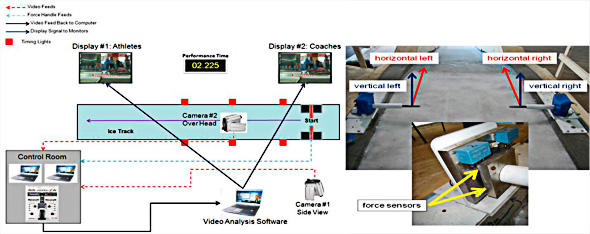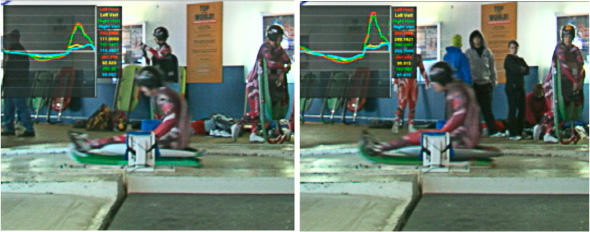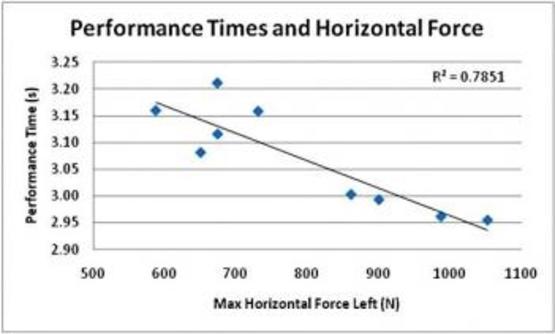Performance Analysis of the Pull Start in Luge
Performance Analysis of the Pull Start in Luge: Integrated and Real-time Use of Video and Force Measurement Technologies
Pro Stergiou (M.Sc.) & Larry Katz (Ph.D.)
Faculty of Kinesiology, Centre for Video and Performance Analysis, Sport Technology Research Lab
University of Calgary, Alberta, Canada
Introduction
A good start in sport of Luge is understood, by the athletes and coach, as a start that produces maximal velocity of the sled with a trajectory that is symmetrical (right to left symmetry) off the handles. Video and force measurement systems have been used to offer the coach and athlete feedback on the kinematics (geometry of motion) and kinetics (external reaction forces). The co-ordination of these two technologies into one real-time feedback system have provided much of the necessary information for the assessment and correction in technique.
The purposes of this study were:
- To create an integrated real-time video and force measurement system to be used in the Canada Olympic Park (Calgary, Alberta).
- To perform analysis on the force data collected from Canadian National Luge team members.
- To provide simple information that could be used by the coaching and technical support staff for improvement of performances of Luge athletes during the pull start.
Video and Force Integration
The co-ordination of the video and the force into one video stream was achieved via a digital integration and mixing of a graphical output of the force trace with the video. This provided feedback of force produced by the athlete on the handles (force information provided as right and left, horizontal and vertical force as four separate signals) overlayed on a sagittal video of the athlete performing the pull. Figure 1 below illustrates the layout of the integrated system and images of the pull handles instrumented with force sensors

Figure 1: Layout of integrated video and force system (left) and of the instrumented force handles (right).
Both video and force data are sent to a central location (Control Room). The force signal is processed on a computer in the Control Room using custom made software. The graph of the force is displayed on the computer in real time. Additionally, force data is stored on a computer in the control room in a text file for future processing. Another computer in the Control Room takes the video feeds from both Cameras #1 and #2. Using digital video mixing equipment, both the graphical display and the video displays are overlaid. One video is fed back to the Video Analysis Software computer located at the start via a fibre optics cable. The video is collected on this computer and the display is sent to 2 plasma display monitors mounted on the wall.
Data Collection
Simultaneous video and force data were collected on nine Luge athletes (total of 45 trials) at the indoor training facility at Canada Olympic Park (Calgary, CANADA). Video data were collected using a digital video camera at 30Hz. Four channels of force data were collected from the right and left pull handles instrumented with force sensors at 1200 Hz (Kistler). Data from the force sensors were stored as individual trails in text files for future processing. Real-time video and force graphs were collected as individual video images for each pull trial. Figure 2 below illustrates a frame of video of two separate athletes with the force graph over top of the video in the top left corner.

Figure 2: Frame of video from data collection of pull start in the sport of Luge. The image on the left is a Junior National athlete and the image on the right is a Senior National athlete.
Data Analysis
All force data were transferred to Microsoft Excel for analysis. Force data consisted of four signals, including right and left (horizontal and vertical). Variables of interest extracted from the continuous force signals included
- Maximal Force Horizontal Left (Hmax Left)
- Maximal Force Vertical Force Left (Vmax Left)
- Maximal Force Horizontal Force Right (Hmax Right)
- Maximal Force Vertical Force Right (Vmax Right)
- Difference Horizontal Force for Right vs. Left (Horz Diff)
- Difference Vertical Force for Right vs. Left (Vert Diff)
- Difference between Horizontal and Vertical Force for Left (Left Diff)
- Difference between Horizontal and Vertical Force for Right (Right Diff)
- Impulse of Force Horizontal Left (Himp Left)
- Impulse of Force Vertical Left (Vimp Left)
- Impulse of Force Horizontal Right(Himp Right)
- Impulse of Force Vertical Right (Vimp Right)
Impulses of the force were calculated as the integral of the force signal for the positive portion of the force trace (positive force was during the forward pulling motion of the sled. R-squared (RSQ) (square of the Person Product Moment Correlations) compared the performance times from the timing lights to each of the above force variables. RSQ values of > 0.500 were considered as high correlations and the meaning of each of these correlations were described in simple terms for the coach and athletes to comprehend. Recommendations were made to the Luge team on how to use the force information to improve performance times.
Results
Table 1 below summarizes the results from the data analysis on the force. High correlations (by our definitions) are highlighted in red text.
Table 1: Data summary of force variables from nine Luge athletes during the pull start. Performance times are listed on the left in blue text. Correlations (RSQ) are listed in the bottom row with high correlations in red highlights.

Based on the above correlations, graphs were created to illustrate the trend. Figure 3 below illustrates the maximal horizontal force of the left handle to the performance times of all nine athletes.

Figure 3: Correlation (RSQ) of the maximal horizontal force of the left handle to the performance time of the Luge athletes.
It is clear from the graph that the performance improves (time lower) as you increase the horizontal force. From Table 1, it is shown generally that increase in horizontal forces (left or right), larger differences between the horizontal and vertical force signals and higher impulses in the horizontal signals all lead to better performances (lower times).
Discussion
The results clearly indicate that having higher horizontal forces, higher impulses (force produced over time) and having a higher horizontal component of the force compared to the vertical component, lead to better performance times in the pull start in the sport of Luge. This information was transferred to the coaching staff and athletes to use on a daily basis during their training sessions. Additionally, the integration software that plots the force information was customized to produce simple numbers that displayed information to track the forces and impulses.
Future Work
Additional customization of this integrated system will include better outputs for the coaches and athletes to simplify the amount of information provided. Also, integration of another technology (an accelerometer) will be included, providing information on the speed of the sled throughout the pull phase. Future data analysis will include compilation of data into one single “Performance Measure” number that will take into consideration many variables.
